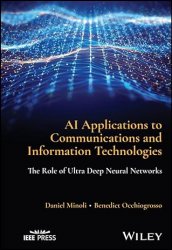AI Applications to Communications and Information Technologies: The Role of Ultra Deep Neural Networks
- Добавил: literator
- Дата: 13-11-2023, 19:45
- Комментариев: 0
 Название: AI Applications to Communications and Information Technologies: The Role of Ultra Deep Neural Networks
Название: AI Applications to Communications and Information Technologies: The Role of Ultra Deep Neural NetworksАвтор: Daniel Minoli, Benedict Occhiogrosso
Издательство: Wiley-IEEE Press
Год: 2024
Страниц: 493
Язык: английский
Формат: pdf (true), epub
Размер: 26.4 MB
Apply the technology of the future to networking and communications.
Artificial Intelligence (AI), which enables computers or computer-controlled systems to perform tasks which ordinarily require human-like intelligence and decision-making, has revolutionized computing and digital industries like few other developments in recent history. Tools like artificial neural networks (ANNs), large language models, and Deep Learning have quickly become integral aspects of modern life. With research and development into AI technologies proceeding at lightning speeds, the potential applications of these new technologies are all but limitless.
AI Applications to Communications and Information Technologies offers a cutting-edge introduction to AI applications in one particular set of disciplines. Beginning with an overview of foundational concepts in AI, it then moves through numerous possible extensions of this technology into networking and telecommunications. The result is an essential introduction for researchers and for technology undergrad/grad student alike.
Artificial Intelligence (AI) is a subfield of Computer Science (CS) that focuses on the creation of computer-based systems, applications, and algorithms that mimic, to the degree possible, some cognitive processes intrinsic to human intelligence. The field has had a long history and is now blossoming in an all-encompassing manner. AI technologies, particularly Machine Learning (ML) and Deep Learning (DL), are becoming ubiquitous in nearly all aspects of modern life. DL is a subfield of ML as discussed below. The goals of learning are (i) understanding a process or phenomenon and (ii) making prediction about outcomes, namely, inferring a function or relationship that maps the input to an output in such a manner that the learned relationship can be used to predict the future output from a future input. AI applications, and ML/DL- based systems in particular, are positioned to take over complex tasks generally performed by humans (decision- makers) or to provide added support to people. Siri, Alexa, augmented reality (AR), autonomous driving, and object recognition are just a few examples of AI applications.
This text focuses on AI/ML/DL applications in the Information and Communications Technology (ICT) sector of the industry, which includes networking, telecommunications, and applications-supporting systems. As the name implies, ICT spans the fields of information technology (IT) and the fundamentally critical communication technologies that make all the modern business and personal applications possible. Some areas where AI is being used in ICT, telecommunications and support operations include but are not limited to the following: network operations monitoring, network management, predictive maintenance, network security and fraud mitigation, customer service, virtual assistants, chatbots, Intelligent Customer Relationship Management systems, and intelligent automation based on AI-supported Robotic Process Automation. Expert systems for network management have been used for decades.
ML endeavors to give computers the ability to learn without being explicitly programmed. ML encompasses the study and construction of algorithms that may learn from existing data and make predictions about new data. These ML mechanisms operate by building a model from training data to make future data-driven predictions or decisions expressed as assessments or outputs. A large number of ML algorithms exist, for example, neural networks (NNs) (also called models), logistic regression, Naive Bayes, Random Forest (RF), matrix factorization, and support vector machines (SVMs), among others. The focus of this textbook is principally, but exclusively, on NNs.
AI Applications to Communications and Information Technologies readers will also find:
In-depth analysis of both current and evolving applications
Detailed discussion of topics including generative AI, chatbots, automatic speech recognition, image classification and recognition, IoT, smart buildings, network management, network security, and more
An authorial team with immense experience in both research and industry
AI Applications to Communications and Information Technologies is ideal for researchers, industry observers, investors, and advanced students of network communications and related fields.
Скачать AI Applications to Communications and Information Technologies: The Role of Ultra Deep Neural Networks
Внимание
Уважаемый посетитель, Вы зашли на сайт как незарегистрированный пользователь.
Мы рекомендуем Вам зарегистрироваться либо войти на сайт под своим именем.
Уважаемый посетитель, Вы зашли на сайт как незарегистрированный пользователь.
Мы рекомендуем Вам зарегистрироваться либо войти на сайт под своим именем.
Информация
Посетители, находящиеся в группе Гости, не могут оставлять комментарии к данной публикации.
Посетители, находящиеся в группе Гости, не могут оставлять комментарии к данной публикации.
